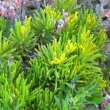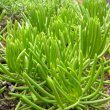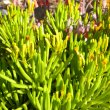| Botanical Name |
|
| Family |
Asteraceae - The daisy family. |
| Pronunciation |
sen-NEESH-shee-oh bar-ber-TON-ee-kus |
| Common Name(s) |
English: Succulent bush senecio
|
| Plant Group |
- Succulent A plant having fleshy stems or leaves often adapted to dry conditions.
|
| Plant Size |
- Large
| Tree | 18m to 25m |
| Shrub | 3m to 4m |
| Perennial/ground cover | 75cm to 1m |
| Bulb | 80cm to 1.2m |
| Succulent | 1m to 1.5m |
|
| Position |
- Canopy Shade Canopy shade is found below closely grown trees where some light filters through. Ideal for the protection of herbaceous plants.
- Partial Shade The area is in shade for part of the day and in full sun for part of the day.
- Sun The area is in full sun for all or most of the day, all year round.
|
| General Information |
- Drought Tolerance: Moderate The plant is moderately adapted to arid conditions and can survive short periods of drought and high temperatures without extra water.
- Evergreen Plants that have leaves all year round.
- Frost: Half-hardy The plant is able to survive low temperatures and some frost but requires protection against severe frost.
- Roots Non-invasive Safe to plant near pools, paving, walls or buildings.
- Water Moderate These plants will need some extra watering compared to water-wise plants. Plant them together, in at least some shade and in a convenient proximity to the house so that grey water can be utilised during times of drought.
|
| Specific Information |
Senecio barbertonicus has not thrived in my lime-rich soil, but it grows well in most other soils as long as they are well-drained. This compact, rounded, evergreen shrub with its bright green, cylindrical leaves creates a useful variation of colour and texture. Use this plant with other shrubs in a herbaceous or shrub border.
|
| Ad Break |
|
| Flowers |
| Description |
tiny flowers tightly clustered in groups at the ends of branches
|
| Season |
- Winter to Summer Plants will seldom bloom for the entire season as given in the list, but should flower during a period within these parameters.
|
| Colour |
|
| Growth Rate |
- Moderate to Fast Specifying growth rate can be very misleading as there is considerable variation of growth rate depending on type and species of plant, available water, supplementary feeding, mulching and general care, as well as the plants suitability and adaptability to the garden environment.
|
| Plant Uses |
- Attracts bees, butterflies or other insects This plant attracts insects which can be food for birds or other creatures in your garden.
- Border A strip of ground, at the edge of a driveway or path in which ornamental plants or shrubs are planted.
- Boundary A plant useful for planting around the edges of the property to form a green or colourful backdrop, an impenetrable hedge, to hide walls or create privacy.
- Container Trees, shrubs and ornamental species that can adapt to growing in a restricted environment.
- Filler Either a fast growing tree or shrub used temporarily to fill in an area while the permanent plants grow to a desired size, or a plant used to fill gaps in borders or beds.
- Foliage Plant Plants grown because their foliage is colorful or unique. Many of these plants have insignificant flowers.
- Hedge Suitable trees or shrubs planted relatively close together so that the branches intertwine to create a barrier. This can be formal – the plants are regularly trimmed to produce a neat shape, or informal – the plants are left to themselves to create a natural hedgerow.
- Rock Garden An area constructed of larger rocks, arranged naturally, to emphasise the use of stones as a main element. Generally plants used do not need a lot of care.
- Stabilize Banks Plant is used to prevent soil erosion because their roots will form a mat that stabilizes the soil and keeps it from washing away in heavy rains.
- Suitable for coastal gardens Plants adapted to dry, sandy soil, forceful wind, limited rainfall and intense sunlight.
- Wild Garden An indigenous garden planted for the benefit of wildlife and birds. Provides food, water, a variety of mini-biomes and no poisonous chemicals are used.
|
| Distribution and Habitat |
Mpumalanga and Limpopo Province, often on the edge of 'krantzes' (rocky cliffs)
|
| Planting Suggestions |
Plant in well-drained soil with some compost and mulch lightly. Water frequently until established, thereafter only when dry.
|
| Medicinal Uses |
|
| Ad Break |
|







Discuss this plant
Share knowledge, ask a question or give an experience.